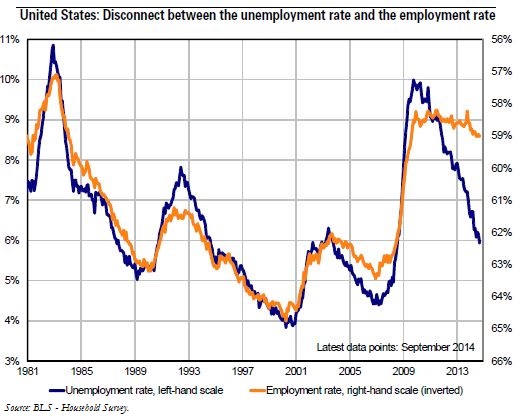Trésor-Economics No. 139 - What’s behind the United States' falling unemployment rate?
The rapid fall in the United States' unemployment rate has been accompanied by a decline in the labour force participation rate that has accelerated since the crisis. After peaking at 10.0% of the labour force at the end of 2009, the unemployment rate has fallen steadily, reaching 5.9% in September 2014. Lower unemployment stems primarily from brisk job creation; however, it occurred against the backdrop of a decline in the labour force participation rate, which stood at 62.7% in September, its lowest level since 1978. A decline in the participation rate automatically caused a drop in the unemployment rate, whereas the employment rate showed little increase. This situation raises questions about the real situation on the US labour market.
About half of the decline in the participation rate following the crisis can be explained by structural changes relating to demographics. Before the crisis, most of the large decline in the participation rate, which fell by 1.1 percentage points between 2000 and 2008, was due to baby-boomers taking retirement. Since then, the decline in the participation rate has accelerated, decreasing by 2.8 percentage points between 2008 and 2013. Demographic factors are estimated to account for approximately half of this decrease, or 1.1 percentage points.
If we adjust for the demographic composition effects, the decline in the participation rate between 2008 and 2010 would appear to be a primarily cyclical phenomenon, but it now seems to be a more structural shift. During the crisis, the decline in the participation rate stemmed mainly from discouraged workers' temporary withdrawal from the labour force as the job market slumped (discouraged worker effects). Nonetheless, despite the US economy's recovery since 2010, the participation rate has continued to decline. The loss of human capital related to the lasting withdrawal of discouraged workers from employment makes their return to the job market less likely (hysteresis effects).
Uncertainty about the structural component of the decline in the participation rate led the Fed to drop its reference to the unemployment rate in its forward guidance. The unemployment rate has systematically fallen faster than projected by the Fed since 2011. Consequently, at the Federal Open Market Committee (FOMC) meeting of March 2014, the Fed dropped the 6.5% unemployment rate target and adopted a wide range of indicators in its place.
The participation rate is likely to continue falling as the population ages. This decline and slower population growth could lead to much slower growth of the United States' labour force. This could reduce the potential growth of the US economy in the long run and ultimately contribute to a lasting decrease in growth in the United States.
